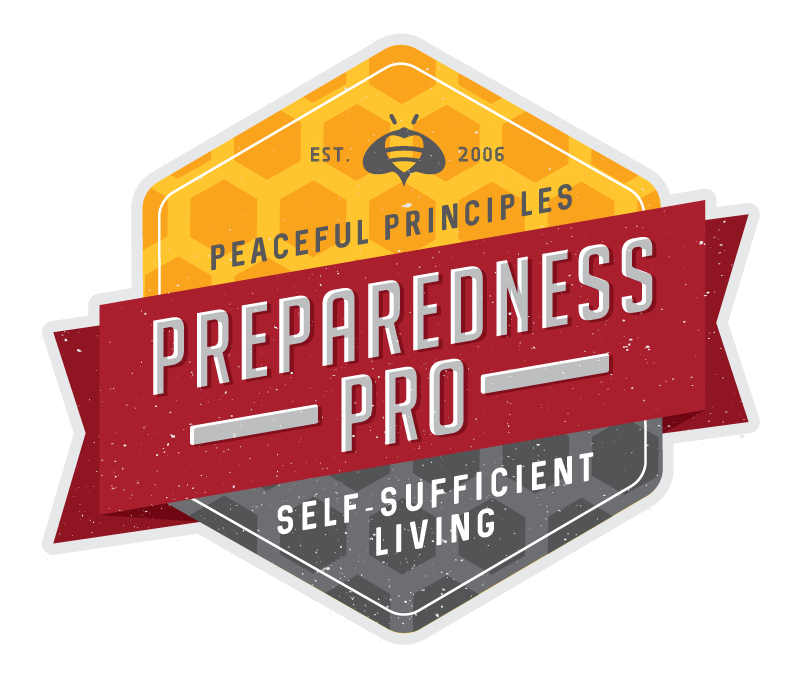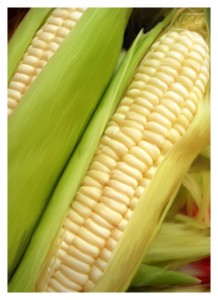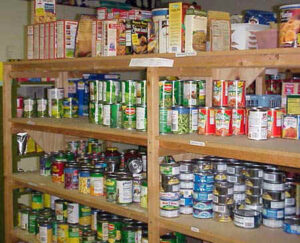by Kellene
Did you know that batteries, diapers, cheese, peanut butter, Coco-cola, Motrin, vanilla extract, baking powder, white vinegar, saccharin, Sweet and Low, charcoal, a slew of household cleaners, drinking alcohol, condiments, toothpaste, dental floss, toilet paper, iodide salt, finger paint, crayons, and margarine all have corn products in them? This list is in addition to the obvious corn products that you are already no doubt familiar with. Corn is in a slew of food additives as well such as maltodextrin, pumaric acid, di-glycerides, Ethel acetate, xanathan gum, semolina, absorbic acid, gluten, citrus cloud emulsion, saccharin, calcium stearate, xylitol, and sorbitol as well as a litany of other “ides, ites, and tols.” Did you also know that
fish, meat, poultry, and pork usually contain corn and have been fed the cheap food of corn? In fact, it’s nearly impossible for anyone to completely avoid contact with CORN nowadays! Corn starch is dusted on your frozen vegetables, corn wax is coated on your fresh vegetables, fish is washed in a corn-derived citric acid, and even when you make that homemade bread from scratch, you’ve still got corn because the baking yeasts often feed on corn based ethanol. (As a bigger eye opener, you may want to view the movie “King Corn” or enjoy blogs authored by Chris Ellis)
So, OK. Our life is permeated with corn.
It’s come to be such thanks to the fact that corn has historically been a cheap commodity. But what happens when corn stops becoming cheap but we find ourselves in a society that’s wholly dependent on corn? You see, the price of your diapers are what they are today based in part on the easy and cheap access to corn. What happens when the price of corn goes way up or corn becomes hard to come by?
Corn crops: 2009. Too wet to plant until late in the season. Too wet to properly fertilize to get a greater yield. Too wet to harvest. Harvested corn repeatedly tested as too wet for dietary corn and storage. And finally there’s also the demand to meet the standard ethanol productions. While drying portions of the crop is possible, it’s also very costly. Corn is typically sold at 10-15% moisture. However this year some of the largest corn growing areas are harvesting it at an average of 22% moisture. (Remember, the more moisture, the more expense to either dry it, or the faster it will go rancid, thus causing a loss of product. Ironically, there have also been some spotty bouts of shortages on propane which is necessary for the drying process. Hmmm…(*note to me, get more propane tanks filled.*) All of this following a 2008 growing season that experienced dramatic rise and drops in harvest prices and expensive fuel prices making harvesting nearly 12% more expensive than previous years. In the first week of January, USDA estimated that 29%
of the Midwestern corn crops were STILL in the fields. That is the demise of our nation’s corn crops this year resulting in anticipated high prices with high demand. The domino effect continues as late corn and soybean harvests delay winter planting as well.
Iowa,Illinois corn harvests extend to December
So, how does all of this translate into for your preparedness efforts? Understand how your food production is reliant on a system as equally tenable as a tightrope act. Pay attention to how the key players are affected so that you can strategically acquire necessary goods before the price hikes come into affect. Attempt to eliminate any food scenarios in which you’re wholly reliant on what is given to you as opposed to what you really want for your family. Become as self-reliant for your nutrition and medical needs as possible. It’s primarily a matter of education and planning.
In parting, I just had another thought. What if 90% of our corn crop were infiltrated solely with genetically modified seed like the soy crops have been? Hmm…
Food Part II: Some Kernels of Truth
Category:
© 2019 Of COURSE this post is Copyright Protected by Preparedness Pro. All Rights Reserved. NO portion of this article may be reposted, printed, copied, disbursed, etc. without first receiving written permission by the author. This content may be printed for personal use only. (Then again, laws are only as good as the people who keep them.) Preparedness Pro will pursue all violations of these rights just as vigorously as she does any of her other freedoms, liberties, and protections.




Comments
Corny as this sounds... sorry, I just had to use that line.
Not surprisingly much of the pet food also contains corn, a cheap filler and not necessarily the most beneficial ingredient for Rover.
As was mentioned in several posts in the past few days, prices are escalating and escalating and continue to escalate. It is not yet too late to procure as much food insurance as feasible for our families (and pets). Some days I seem a little crazed, adding to my list of things to purchase "when my ship comes in" and buying now the highest priority items that fit the budget. This past year my mantra has been "Need or Want??" and most purchases were determined with that simple phrase. Glen Beck has said on more than one occasion that if we have even an extra dollar that we should purchase food and I agree. It will be the best investment that we have in the event of a crisis, whether a personal economic disaster or a national event. Kudos Kellene for again heightening our awareness!
I had no idea that so many things had corn in them. The price of corn went up when they started using so much of it as an alternate fuel for cars. Now, with all of the crop shortages, it will go up some mroe. Corn is one of my favorite foods, and I put it in most soups, casarole dishes, as well as just plain corn. I even have corn that I can grind into corn meal with my grinder.
There are so many shortages coming up it is hard to determine which ones to stock up on now, and which ones to wait until the next pay check. I know that wheat is in short supply, corn, sugar, and fruits and vegetables as well. I don't know about rice at this time. If you were starting from scratch right now, which would you work on first. I know that at some point there will be a famine. Thank goodness I am not starting from scratch now. But I can only buy a few things at a time, so I always pray for guidence when getting prepared.
Thank you, Kellene, for all of your work, and advice, and especially the warnings.
Believer, If I only had one grain that I could get, it would be wheat. If I had a little bit more money to buy something else, it would be sprouts. Just FYI.
Great info - thanks for the steadfast heads-up. I'm increasing my storage as fast as I can. Will be trying my hand at sprouts soon; and a small garden later this year also. I paid $0.90 for a single tomato the other day, and it wasn't in great shape (not many to choose from either). Bummer - I love tomatos and now there's a shortage.
http://www.freshplaza.com/news_detail.asp?id=56441
Can't wait to pick my first one from the vine... I grew up in central IL - farm country. On my visit last year, I got to see and hear about the devasted fields. The pumpkin fields in Morton, IL were a total loss. It was the first year in its history they couldn't hold the annual Morton pumpkin festival. This is real - thanks Kellene.
Kellene,
You may want to talk to everyone about the serious effects of eating only corn. Corn does not contain 2 vital nutrients. Niacin, and tryptophan. During the Great Depression, there were areas in the south that subsisted solely on corn. Because this is all they had. The Doctor who discovered the culprits was named Dr. Goldberger. It effected orphanages and prisons. This caused a serious medical condition called "pellagra." This disease can be DEADLY! You can google Pellagra for all the info.
We all need to know about any kind of problems that could arise, so as to plan accordingly.
Love your articles and look forward to each, and every one!!! Thanks. P.
AG weekly says "Difficult Growing Season. Producers struggled to plant the corn and soybean crop this spring due to El Nino and extremely wet conditions. During the summer, a cool summer kept growing degree days to a minimum and delayed the maturity of the crop. Heavy rains in October limited the harvest activity and some of the corn and soybean crops will not be able to be harvested until the spring."
Does anyone know where I may find out how to read the USDA Reports? The 2010 report is out but much of the data seems to contridicted by other reports by the USDA. After 13 years in the military and being a volunteer for 5 years under DHS I thought I was pretty good at reading Governmenteese. LOL
I did find this (special article in this report “Tight Supplies
Expected to Sustain High U.S. Sugar Prices into 2009/10”)
Rain and low temperatures since the beginning of October have affected the sugar beet harvest in northern growing areas. This has resulted in lower sugar beet yields (down from 28.2 tons/acre projected in August to 25.8 tons/acre estimated at the end of the harvest) and, by processor reports, lower beet sucrose levels. The forecast sugar beet crop in the Red River Valley is 13.5-percent lower (15.324 million tons) than the forecast in August (17.709 million tons). The crop forecast in Michigan is down by 9.6 percent from August’s 3.672 million tons to 3.318 million tons. Also, the Great Plains crop is down 5.8 percent from August (3.907 million tons compared with 4.147 million tons). Only in the Pacific Northwest and California is the crop forecast about the same as in August (6.970 million tons).
Wheat and Rice seem to be recovering somewhat. Wheat harvest in 2008 was the lowest since the 1940's and is up slightly in 09. Rice harvest is up 8% from 2008. Medium and Shortgrain rice had the highest jump in harvesrted rice.
I am still looking for the "Corn Report 2010" at USDA.
Jamie, that is a frustration. The USDA has SEVERAL conflicting reports on their own site and in circulation. Grrr...
I am so puzzled by this my state gave me a nice break down of all 3 regions in Idaho. Northern Idaho is had a very bad year, harvest down because a bad weather. SW Idaho did great bumper crops in almost everything Potatoes, Wheat (HRW)and Fruit(Apples,Cherries Grapes, etc) SE Idaho not so great, bad hailstorm damaged a lot of plants and did have an effect on the harvest. Not terrible, but not great.
I read through over 50+ years of tax laws enacted by Congress to find the answer to a question. I did find the answer, I had to go back to the Congress of 1947 to find it, but I did. The USDA Reports just give me fits.
Stephen Hawking "A Short History of Time" is easier to understand.
@ Scott I would recommend you buy canned tomatoes right now if you are getting poor quality fresh. Alton Brown had a great show on tomatoes on food network. You maybe able to watch it online or get a schedule of his upcoming shows. He also believes in a well stocked "Pantry" and Multi-taskers.
That should give you a place to start until you get your garden growing.